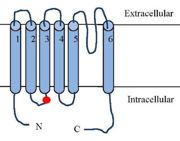Sandbox Reserved 1652
From Proteopedia
(Difference between revisions)
| Line 85: | Line 85: | ||
The absorption through the skin of these creams generated partial desensitization of the nerve endings. This is the cause of a decrease in painful sensations.<ref name="TRPV1 dans les neuropathies douloureuses - Des modèles animaux aux perspectives thérapeutiques"> <ref>A. Danigo, L. Magy, et C. Demiot, « TRPV1 dans les neuropathies douloureuses - Des modèles animaux aux perspectives thérapeutiques », médecine/sciences, vol. 29, no 6‑7, Art. no 6‑7, juin 2013, doi: 10.1051/medsci/2013296012.</ref> | The absorption through the skin of these creams generated partial desensitization of the nerve endings. This is the cause of a decrease in painful sensations.<ref name="TRPV1 dans les neuropathies douloureuses - Des modèles animaux aux perspectives thérapeutiques"> <ref>A. Danigo, L. Magy, et C. Demiot, « TRPV1 dans les neuropathies douloureuses - Des modèles animaux aux perspectives thérapeutiques », médecine/sciences, vol. 29, no 6‑7, Art. no 6‑7, juin 2013, doi: 10.1051/medsci/2013296012.</ref> | ||
[https://en.wikipedia.org/wiki/Capsazepine Capsazepine] is a synthetic competitive antagonist of this receptor which is currently used to study TRPV1 function. | [https://en.wikipedia.org/wiki/Capsazepine Capsazepine] is a synthetic competitive antagonist of this receptor which is currently used to study TRPV1 function. | ||
| - | Many laboratories are conducting clinical studies on oral TRPV1 antagonists: [https://fr.wikipedia.org/wiki/GlaxoSmithKline GlaxoSmithKline ], [https://en.wikipedia.org/wiki/Amgen Amgen], [https://en.wikipedia.org/wiki/Merck_%26_Co. Merck]-Neurogen, [https://en.wikipedia.org/wiki/Abbott_Laboratories], [https://en.wikipedia.org/wiki/Eli_Lilly_and_Company], [https://en.wikipedia.org/wiki/AstraZeneca AstraZeneca] and [https://en.wikipedia.org/wiki/Japan_Tobacco Japan Tobacco]. Nowadays at least seven orally active TRPV1 antagonist substances successfully went for clinical development and the laboratories cited before all completed phase I trials . However some of them have stopped their researches at phase II trials by unknown reason as GlaxoSmithKline | + | Many laboratories are conducting clinical studies on oral TRPV1 antagonists: [https://fr.wikipedia.org/wiki/GlaxoSmithKline GlaxoSmithKline ], [https://en.wikipedia.org/wiki/Amgen Amgen], [https://en.wikipedia.org/wiki/Merck_%26_Co. Merck]-Neurogen, [https://en.wikipedia.org/wiki/Abbott_Laboratories Abbott], [https://en.wikipedia.org/wiki/Eli_Lilly_and_Company Eli Lilly], [https://en.wikipedia.org/wiki/AstraZeneca AstraZeneca] and [https://en.wikipedia.org/wiki/Japan_Tobacco Japan Tobacco]. Nowadays at least seven orally active TRPV1 antagonist substances successfully went for clinical development and the laboratories cited before all completed phase I trials . However some of them have stopped their researches at phase II trials by unknown reason as GlaxoSmithKline |
with the antagonist SB-705498 or Lilly with the antagonist GRC 6211. <ref name="SB-705498"> The National Center for Advancing Translational Sciences «SB-705498 » , https://drugs.ncats.io/drug/T74V9O0Y2W, (Consulté le: déc. 29, 2021)</ref> <ref name="Further Clinical Trials in Osteoarthritis Pain Suspended for GRC 6211"> Calisha Myers, 24 oct. 2008, «Further Clinical Trials in Osteoarthritis Pain Suspended for GRC 6211 » , https://www.fiercebiotech.com/biotech/further-clinical-trials-osteoarthritis-pain-suspended-for-grc-6211, (Consulté le: déc. 29, 2021)</ref> | with the antagonist SB-705498 or Lilly with the antagonist GRC 6211. <ref name="SB-705498"> The National Center for Advancing Translational Sciences «SB-705498 » , https://drugs.ncats.io/drug/T74V9O0Y2W, (Consulté le: déc. 29, 2021)</ref> <ref name="Further Clinical Trials in Osteoarthritis Pain Suspended for GRC 6211"> Calisha Myers, 24 oct. 2008, «Further Clinical Trials in Osteoarthritis Pain Suspended for GRC 6211 » , https://www.fiercebiotech.com/biotech/further-clinical-trials-osteoarthritis-pain-suspended-for-grc-6211, (Consulté le: déc. 29, 2021)</ref> | ||
The research on the antagonists of TRPV1 remains encouraging. <ref name="TRPV1 antagonists that cause hypothermia, instead of hyperthermia, in rodents: Compounds’ pharmacological profiles, in vivo targets, thermoeffectors recruited and implications for drug development"> A. Garami,E. Pakai,H. A. McDonald,R. M. Reilly,A. Gomtsyan,J. J. Corrigan,E. Pinter,D. X. D. Zhu,S. G. Lehto,N. R. Gavva,P. R. Kym,A. A. Romanovsky, 20 jan. 2018, «TRPV1 antagonists that cause hypothermia, instead of hyperthermia, in rodents: Compounds’ pharmacological profiles, in vivo targets, thermoeffectors recruited and implications for drug development » ,https://onlinelibrary.wiley.com/doi/full/10.1111/apha.13038 | The research on the antagonists of TRPV1 remains encouraging. <ref name="TRPV1 antagonists that cause hypothermia, instead of hyperthermia, in rodents: Compounds’ pharmacological profiles, in vivo targets, thermoeffectors recruited and implications for drug development"> A. Garami,E. Pakai,H. A. McDonald,R. M. Reilly,A. Gomtsyan,J. J. Corrigan,E. Pinter,D. X. D. Zhu,S. G. Lehto,N. R. Gavva,P. R. Kym,A. A. Romanovsky, 20 jan. 2018, «TRPV1 antagonists that cause hypothermia, instead of hyperthermia, in rodents: Compounds’ pharmacological profiles, in vivo targets, thermoeffectors recruited and implications for drug development » ,https://onlinelibrary.wiley.com/doi/full/10.1111/apha.13038 | ||
Revision as of 10:05, 30 December 2021
| This Sandbox is Reserved from 26/11/2020, through 26/11/2021 for use in the course "Structural Biology" taught by Bruno Kieffer at the University of Strasbourg, ESBS. This reservation includes Sandbox Reserved 1643 through Sandbox Reserved 1664. |
To get started:
More help: Help:Editing |
The Transient Receptor Potential cation channel subfamily V member 1 TRPV1
| |||||||||||
References
- ↑ 1.0 1.1 1.2 Wikipedia contributors. (2020, december 21). TRPV1. Wikipedia. https://en.wikipedia.org/wiki/TRPV1 (Consulted the: dec. 28, 2020). [Online].
- ↑ 2.0 2.1 A. Danigo, L. Magy et C. Demiot , Med Sci (Paris) Volume 29, Number 6-7, Juin–Juillet 2013, p. 597-606. TRPV1 dans les neuropathies douloureuses, https://www.medecinesciences.org/en/articles/medsci/full_html/2013/08/medsci2013296-7p597/medsci2013296-7p597.html, (Consulted the : dec. 23, 2021). [Online].
- ↑ 3.0 3.1 3.2 3.3 3.4 3.5 Liao, M., Cao, E., Julius, D., & Cheng, Y. (2013b). Structure of the TRPV1 ion channel determined by electron cryo-microscopy. Nature, 504(7478), 107‑112. https://doi.org/10.1038/nature12822(consulté le déc. 28, 2020)
- ↑ T. Rosenbaum et S. A. Simon, « TRPV1 Receptors and Signal Transduction », in TRP Ion Channel Function in Sensory Transduction and Cellular Signaling Cascades, W. B. Liedtke et S. Heller, Éd. Boca Raton (FL): CRC Press/Taylor & Francis, 2007
- ↑ 5.0 5.1 5.2 5.3 5.4 G. Smutzer et R. K. Devassy, « Integrating TRPV1 Receptor Function with Capsaicin Psychophysics », Advances in Pharmacological Sciences, janv. 14, 2016
- ↑ R. Kumar, A. Hazan, A. Basu, N. Zalcman, H. Matzner, et A. Priel, « Tyrosine Residue in the TRPV1 Vanilloid Binding Pocket Regulates Deactivation Kinetics », J. Biol. Chem., vol. 291, no 26, p. 13855‑13863, juin 2016, doi: 10.1074/jbc.M116.726372.
- ↑ X. Yao, H.-Y. Kwan, et Y. Huang, « Regulation of TRP Channels by Phosphorylation », Neurosignals, vol. 14, no 6, p. 273‑280, 2005, doi: 10.1159/000093042
- ↑ F. Yang et J. Zheng, « Understand spiciness: mechanism of TRPV1 channel activation by capsaicin », Protein Cell, vol. 8, no 3, p. 169‑177, mars 2017, doi: 10.1007/s13238-016-0353-7.
- ↑ F. Yang et al., « Structural mechanism underlying capsaicin binding and activation of the TRPV1 ion channel », Nat. Chem. Biol., vol. 11, no 7, Art. no 7, juill. 2015, doi: 10.1038/nchembio.1835.
- ↑ F. Yang et al., « The conformational wave in capsaicin activation of transient receptor potential vanilloid 1 ion channel », Nat. Commun., vol. 9, no 1, Art. no 1, juill. 2018, doi: 10.1038/s41467-018-05339-6.
- ↑ 11.0 11.1 K. Elokely et al., « Understanding TRPV1 activation by ligands: Insights from the binding modes of capsaicin and resiniferatoxin », Proc. Natl. Acad. Sci., vol. 113, no 2, p. E137‑E145, janv. 2016, doi:10.1073/pnas.1517288113.
- ↑ <ref>John Joseph, L. Qu, S. Wang, M. Kim, D. Bennett, J. Ro, M. J. Caterina and MK. Chung, Journal of Neuroscience 11 December 2019, 39 (50) 9954-9966. https://www.jneurosci.org/content/39/50/9954 (Consulté le: déc. 23, 2021). [En ligne].</li> <li id="cite_note-12">[[#cite_ref-12|↑]] K. W. Ho, N. J. Ward, et D. J. Calkins, « TRPV1: a stress response protein in the central nervous system », Am. J. Neurodegener. Dis., vol. 1, no 1, p. 1‑14, avr. 2012.</li> <li id="cite_note-13">[[#cite_ref-13|↑]] G. Bhave et al., « Protein kinase C phosphorylation sensitizes but does not activate the capsaicin receptor transient receptor potential vanilloid 1 (TRPV1) », Proc. Natl. Acad. Sci., vol. 100, no 21, p. 12480‑12485, oct. 2003, doi: 10.1073/pnas.2032100100.</li> <li id="cite_note-TRPV1_dans_les_neuropathies_douloureuses_-_Des_mod.C3.A8les_animaux_aux_perspectives_th.C3.A9rapeutiques-14">[[#cite_ref-TRPV1_dans_les_neuropathies_douloureuses_-_Des_mod.C3.A8les_animaux_aux_perspectives_th.C3.A9rapeutiques_14-0|↑]] <ref>A. Danigo, L. Magy, et C. Demiot, « TRPV1 dans les neuropathies douloureuses - Des modèles animaux aux perspectives thérapeutiques », médecine/sciences, vol. 29, no 6‑7, Art. no 6‑7, juin 2013, doi: 10.1051/medsci/2013296012.</li> <li id="cite_note-SB-705498-15">[[#cite_ref-SB-705498_15-0|↑]] The National Center for Advancing Translational Sciences «SB-705498 » , https://drugs.ncats.io/drug/T74V9O0Y2W, (Consulté le: déc. 29, 2021)</li> <li id="cite_note-Further_Clinical_Trials_in_Osteoarthritis_Pain_Suspended_for_GRC_6211-16">[[#cite_ref-Further_Clinical_Trials_in_Osteoarthritis_Pain_Suspended_for_GRC_6211_16-0|↑]] Calisha Myers, 24 oct. 2008, «Further Clinical Trials in Osteoarthritis Pain Suspended for GRC 6211 » , https://www.fiercebiotech.com/biotech/further-clinical-trials-osteoarthritis-pain-suspended-for-grc-6211, (Consulté le: déc. 29, 2021)</li> <li id="cite_note-TRPV1_antagonists_that_cause_hypothermia.2C_instead_of_hyperthermia.2C_in_rodents:_Compounds.E2.80.99_pharmacological_profiles.2C_in_vivo_targets.2C_thermoeffectors_recruited_and_implications_for_drug_development-17">[[#cite_ref-TRPV1_antagonists_that_cause_hypothermia.2C_instead_of_hyperthermia.2C_in_rodents:_Compounds.E2.80.99_pharmacological_profiles.2C_in_vivo_targets.2C_thermoeffectors_recruited_and_implications_for_drug_development_17-0|↑]] A. Garami,E. Pakai,H. A. McDonald,R. M. Reilly,A. Gomtsyan,J. J. Corrigan,E. Pinter,D. X. D. Zhu,S. G. Lehto,N. R. Gavva,P. R. Kym,A. A. Romanovsky, 20 jan. 2018, «TRPV1 antagonists that cause hypothermia, instead of hyperthermia, in rodents: Compounds’ pharmacological profiles, in vivo targets, thermoeffectors recruited and implications for drug development » ,https://onlinelibrary.wiley.com/doi/full/10.1111/apha.13038 , (Consulté le: déc. 29, 2021)</li></ol></ref>


